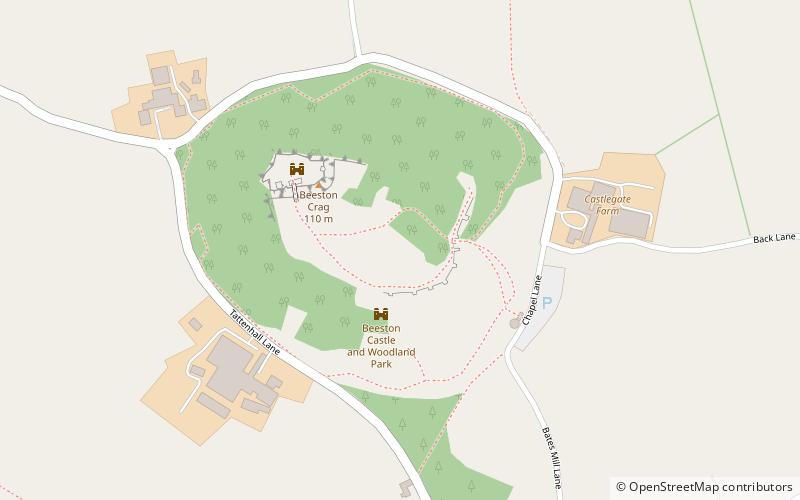Bishop Bennet Way
#1650 among destinations in the United Kingdom


Facts and practical information
The Bishop Bennet Way is a bridleway in south west Cheshire, England. It is named after William Bennet, Bishop of Cork and Ross and subsequently Bishop of Cloyne, who carried out detailed surveys of Roman roads including those between Deva and Mediolanum. ()
EnglandUnited Kingdom
Bishop Bennet Way – popular in the area (distance from the attraction)
Nearby attractions include: Beeston Castle, Oulton Park, Sandstone Trail, Peckforton Castle.
 Forts and castles, Historical place
Forts and castles, Historical placeBeeston Castle
3 min walk • Beeston Castle, crowning a rocky crag with sweeping views over the Cheshire countryside, is a fortress steeped in history and legend. This medieval castle, now in ruins, was built in the 1220s by Ranulf de Blondeville, 6th Earl of Chester, on the site of an earlier...
 Racetrack, Sport venue, Sport
Racetrack, Sport venue, SportOulton Park, Tarporley
120 min walk • Oulton Park is a hard surfaced track used for motor racing, close to the village of Little Budworth, Cheshire, England. It is about 5 miles from Winsford, 13 miles from Chester city centre, 8 miles from Northwich and 17 miles from Warrington, with a nearby rail connection along the Mid-Cheshire Line.
 Hiking, Hiking trail
Hiking, Hiking trailSandstone Trail
22 min walk • The Sandstone Trail is a 55-kilometre long-distance walkers' path, following sandstone ridges running north–south from Frodsham in central Cheshire to Whitchurch just over the Shropshire border. The path was created in 1974 and extended in the 1990s.
 Forts and castles
Forts and castlesPeckforton Castle
20 min walk • Peckforton Castle is a Victorian country house built in the style of a medieval castle. It stands in woodland at the north end of Peckforton Hills one mile northwest of the village of Peckforton, Cheshire, England. It is recorded in the National Heritage List for England as a designated Grade I listed building.
 Forts and castles, Garden, Park
Forts and castles, Garden, ParkCholmondeley Castle
124 min walk • Cholmondeley Castle is a country house in the civil parish of Cholmondeley, Cheshire, England. Together with its adjacent formal gardens, it is surrounded by parkland. The site of the house has been a seat of the Cholmondeley family since the 12th century. The present house replaced a timber-framed hall nearby.
 Church
ChurchSt Boniface's Church
52 min walk • St Boniface's Church stands prominently in the village of Bunbury, Cheshire, England. It is recorded in the National Heritage List for England as a designated Grade I listed building. The church dates mainly from the 14th century.
 Forts and castles
Forts and castlesMaiden Castle
119 min walk • Maiden Castle is an Iron Age hill fort, one of many fortified hill-top settlements constructed across Britain during the Iron Age, but one of only seven in the county of Cheshire in northern England.
 Canal
CanalBarbridge Junction
124 min walk • Barbridge Junction is the name of the canal junction located at Barbridge, Cheshire, where the Shropshire Union Canal Middlewich Branch terminates and meets the Shropshire Union Canal main line.
 Museum, Historical place
Museum, Historical placeBunbury Mill
57 min walk • Bunbury Mill is a watermill located to the east of the village of Bunbury, Cheshire, England. After being at risk of demolition, it has been restored as a working museum. The structure is designated by Historic England as a Grade II listed building.
 Church, Gothic Revival architecture, Gothic architecture
Church, Gothic Revival architecture, Gothic architectureSt Helen's Church, Tarporley
59 min walk • St Helen's Church is in the village of Tarporley, Cheshire, England. It is an active Anglican parish church in the diocese of Chester, the archdeaconry of Chester and the deanery of Malpas.
 Forts and castles
Forts and castlesKelsborrow Castle, Kelsall
133 min walk • Kelsborrow Castle is an Iron Age hill fort in Cheshire, northern England. Hill forts were fortified hill-top settlements constructed across Britain during the Iron Age.
